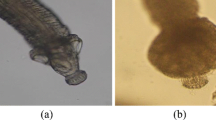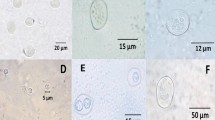Abstract
The effect of praziquantel in vitro at concentrations of 5, 50 and 500 ppm for 1 h resulted in the progressive breakdown of the tegument and in morphologic distortion of adultEchinococcus granulosus when compared to controls. Scanning electron microscopy of all specimens treated in the various concentrations of praziquantel showed loss of most, if not all, of the rostellar hooks and changes in the structure of the suckers. Many of the tapeworms immediately detached from the host's gut upon being placed in the drug, and all treated cestodes exhibited contraction or swelling, particularly in the penultimate proglottid. Intense contraction was apparent in the worms exposed to the higher drug concentrations. Characteristic conical microtriches on the terminal proglottid, as observed in the control specimens, became fused and matted when exposed to 5 ppm of praziquantel. At a drug concentration of 50 ppm, the tegumental surface developed grooves or furrows between clumps of fused microtriches, while 500 ppm caused production of holes within the denuded tegument of the parasite. Ovoid bodies, presumed to be eggs, were observed on the outer surfaces and just below the tegument of tapeworms treated with concentrations of 50 ppm. These structures also appeared to adhere to the outer surfaces of specimens exposed to 500 ppm. In view of the foregoing, special care should be taken in handling and disposing of feces from infected or suspect dogs after praziquantel treatment, since the breakdown in the tegumental surface ofE. granulosus presumably results in the release of potentially infective eggs.
Similar content being viewed by others
References
Andersen FL, Conder GA, Marsland WP (1978) Efficacy of injectable and tablet formulations of praziquantel against matureEchinococcus granulosus. Amer J Vet Res 39:1861–1862
Andersen FL, Conder GA, Marsland WP (1979) Efficacy of injectable and tablet formulations of praziquantel against immatureEchinococcus granulosus. Amer J Vet Res 40:700–701
Andrews P (1976) Pharmacokinetic studies with Droncit® in animals using a biological assay. Vet Med Rev 154–165
Andrews P, Thomas H (1979) The effect of praziquantel onHymenolepis diminuta in vitro. Tropenmed Parasitol 30:391–400
Becker B, Mehlhorn H, Andrews P, Thomas H (1980a) Scanning and transmission electron microscope studies on the efficacy of praziquantel onHymenolepis nana (Cestoda) in vitro. Z Parasitenkd 61:121–133
Becker B, Mehlhorn H, Andrews P, Eckert J (1980b) Light and electron microscopic studies on the effect of praziquantel onSchistosoma mansoni, Dicrocoelium dendriticum, andFasciola hepatica (Trematoda) in vitro. Z Parasitenkd 63:113–128
Borgers M, deNollin S, Verheyen A, Vanparijs O, Thienpont D (1975) Morphological changes in cysticerci ofTaenia taeniaeformis after mebendazole treatment. J Parasitol 61:830–843
Chavasse CJ, Brown MC, Bell DR (1979)Schistosoma mansoni: Activity responses in vitro to praziquantel. Z Parasitenkd 58:169–174
Coles GC (1979) The effect of praziquantel onSchstosoma mansoni. J Helminthol 53:31–33
Conder GA, Crellin JR, Andersen FL (1981) Comparative evaluation of collection and fixation techniques forEchinococcus granulosus. Proc Helm Soc Wash 48:101–103
Dey-Hazra A (1976) Die Wirkung von Droncit® (Praziquantel) auf Bandwurminfektionen bei Hund und Katze. Vet Med Nachr 2:134–141
Fetterer RH, Pax RA, Bennett JL (1980) Praziquantel, potassium and 2, 4-dinitrophenol: analysis of their action on the musculature ofSchistosoma mansoni. Eur J Pharmacol 64:31–38
Gemmell MA, Johnstone PD, Oudemans G (1977) The effect of praziquantel onEchinococcus granulosus, Taenia hydatigena andTaenia ovis infections in dogs. Res Vet Sci 23:121–123
Hart RJ, Turner R, Wilson RG (1977) A biochemical and ultrastructural study of the mode of action of bunamidine againstHymenolepis nana. Int J Parasitol 7:129–134
Hayat MA (1978) Introduction to Biological Scanning Electron Microscopy. University Park Press, Baltimore
Pax RA, Bennett JL, Fetterer RH (1978) A benzodiazepine derivative and praziquantel: effects on musculature ofSchistosoma mansoni andSchistosoma japonicum. Naunyn-Schmiedeberg's Arch Pharmacol 304:309–315
Rim H-J, Park S-B, Lee J-S, Joo K-H (1979) Therapeutic effects of praziquantel (Embay 8440) againstTaenia solium infection. Kor J Parasitol 17:67–72
Sakamoto T (1977) The anthelmintic effect of Droncit® on adult tapeworms ofHydatigera taeniaeformis, Mesocestoides corti, Echinococcus multilocularis, Diphyllobothrium erinacei andD. latum. Vet Med Rev 64–74
Soulsby EJL (1968) Cestodes. In: EJL Soulsby (ed) Helminths, arthropods and protozoa of domesticated animals (Mönnig), 6th edition, Williams & Wilkins, Baltimore, p 88–141
Thakur AS, Prezioso U, Marchevsky N (1979)Echinococcus granulosus: ovicidal activity of praziquantel and bunamidine hydrochloride. Exp Parasitol 47:131–133
Thomas H, Andrews P (1977) The efficacy of praziquantel against cestodes in animals. Z Parasitenkd 52:117–127
Thomas H, Gönnert R (1978) The efficacy of praziquantel against cestodes in cats, dogs and sheep. Res Vet Sci 24:20–25
Verheyen A, Vanparijs O, Borgers M, Theinpont D (1978) Scanning electron microscopic observations ofCysticercus fasciolaris (=Taenia taeniaeformis) after treatment of mice with mebendazole. J Parasitol 64:411–425
Author information
Authors and Affiliations
Rights and permissions
About this article
Cite this article
Conder, G.A., Marchiondo, A.A. & Andersen, F.L. Effect of praziquantel on adultEchinococcus granulosus in vitro: Scanning electron microscopy. Z. Parasitenkd. 66, 191–199 (1981). https://doi.org/10.1007/BF00925726
Received:
Issue Date:
DOI: https://doi.org/10.1007/BF00925726




